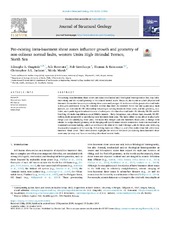| dc.contributor.author | Osagiede, Edoseghe Edwin | |
| dc.contributor.author | Rotevatn, Atle | |
| dc.contributor.author | Gawthorpe, Rob | |
| dc.contributor.author | Kristensen, Thomas Berg | |
| dc.contributor.author | Jackson, Christopher | |
| dc.contributor.author | Marsh, Nicola | |
| dc.date.accessioned | 2020-08-12T12:36:16Z | |
| dc.date.available | 2020-08-12T12:36:16Z | |
| dc.date.issued | 2020 | |
| dc.Published | Osagiede EE, Rotevatn A, Gawthorpe R L, Kristensen TB, Jackson C, Marsh. Influence of pre-existing intra-basement shear zones on the development of non-colinear rift fault network, Utsira High – Heimdal Terrace, North Sea. Journal of Structural Geology. 2020;130:103908 | eng |
| dc.identifier.issn | 0191-8141 | en_US |
| dc.identifier.issn | 1873-1201 | en_US |
| dc.identifier.uri | https://hdl.handle.net/1956/23690 | |
| dc.description.abstract | Pre-existing intra-basement shear zones can induce mechanical and rheological heterogeneities that may influence rifting and the overall geometry of rift-related normal faults. However, the extent to which physical and kinematic interaction between pre-existing shear zones and younger rift faults control the growth of normal faults is less-well understood. Using 3D reflection seismic data from the northern North Sea and quantitative fault analysis, we constrain the 3D relationship between pre-existing basement shear zones, and the geometry, evolution, and synrift depositional architecture of subsequent rift-related normal faults. We identify NE-SW- and N-S-striking rift faults that define a coeval Middle Jurassic – Early Cretaceous, non-colinear fault network. NE-SW-striking faults are parallel to underlying intra-basement shear zone. The faults either tip-out above or physically merge with the underlying shear zone. For faults that merges with the basement shear zone, a change from tabular to wedge-shaped geometry of the hangingwall synrift strata records a transition from non-rotational to rotational extension faulting, which we attribute to the time of rift fault's linkage with the shear zone, following downward propagation of its lower tip. N-S-striking faults are oblique to, and offset (rather than link with) intra-basement shear zones. These observations highlight the selective influence pre-existing intra-basement shear zones may (or may not) have on evolving rift-related normal faults. | en_US |
| dc.language.iso | eng | eng |
| dc.publisher | Elsevier | en_US |
| dc.rights | Attribution CC BY | eng |
| dc.rights.uri | http://creativecommons.org/licenses/by/4.0/ | eng |
| dc.title | Pre-existing intra-basement shear zones on the development of non-colinear rift fault network, Utsira High – Heimdal Terrace, North Sea | en_US |
| dc.type | Peer reviewed | |
| dc.type | Journal article | |
| dc.date.updated | 2020-01-05T09:37:27Z | |
| dc.description.version | publishedVersion | en_US |
| dc.rights.holder | Copyright 2019 The Authors | en_US |
| dc.identifier.doi | https://doi.org/10.1016/j.jsg.2019.103908 | |
| dc.identifier.cristin | 1766251 | |
| dc.source.journal | Journal of Structural Geology | |
| dc.relation.project | VISTA: VISTA | |
| dc.relation.project | Norges forskningsråd: 255229 | |

